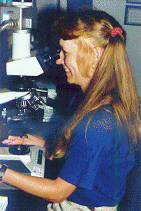
Christine A. Sundermann
Professor
Protozoology, Parasitology
OFFICE: 116 Cary Hall
PHONE: (334) 844-3929, FAX: 334 844 4065
E-MAIL: sundeca@mail.auburn.edu
Research/Interests
Research centers around free-living and parasitic protozoa. These single-celled organisms make excellent models for cellular function, and their life histories alone make them fascinating to study. Development of coccidial parasites in vitro is an exciting area of investigation. Caryospora bigenetica, a coccidian of snakes and mammals has been grown at low temperature in viper cells and at 37C in mammalian cells; it is one of the few coccidia to complete its entire life cycle in vitro. Transmission electron microscopy has been used to help characterize differences in stages that grow in reptiles and mammals. Infections in cotton rats, dogs, and pigs have been characterized. Some hosts (i.e., rats, dogs) seem more prone to disease than others (e.g., pigs). A study of different routes of transmission including transplacental have shown that numerous routes of inoculation can start an infection in mammals. Toxoplasma gondii, a coccidian of man, other mammals, and birds has also been investigated. Formation of cysts in vitro has been characterized for different isolates with respect to timing of developmental events using light, electron, and confocal microscopy. Monoclonal antibodies against apical complex organelles are being used to determine the role that these structures play during an infection. Another area of interest is the insulin binding capacity of Tetrahymena pyriformis, a free- living ciliate. This protozoan exhibits a phenomenon known as hormonal imprinting where a cell, after it has "seen" insulin for a short exposure time, remembers the hormone. Thereafter it responds to insulin (by binding it) much more vigorously and quickly. This memory can last for a long time through many cell generations.
Completed Theses/Dissertations:
- Ron Van Houten, 1995. Ph.D. Selected studies on the In Vivo and In Vitro Development of Caryospora bigenetica and Toxoplasma gondii.
- Gayle K. Christopher, 1994. Ph.D. Selected Studies of Cellular Function in the ciliated Protozoan Tetrahymena.
- Robert J. Douglas, 1992. M.S. Selected Studies on Caryospora bigenetica, a Coccidian of Snakes and Mammals.
- Stephanie A. Stafford, 1990. M.S. An Ultrastructural, Electrophoretical and Light Microscopical Study of Development in Selected Species of Eimeria in the Mouse (Mus musculus).
- Elizabeth B. Gargus, 1986. M.S. New Observations of the In Vivo and In Vitro Development of Eimeria tuskegeensis (Protozoa: Apicomplexa).
Selected Publications:
- Christopher, G.K. & Sundermann, C.A. 1995. Effect of long-term insulin exposure on insulin binding in Tetrahymena pyriformis. Tissue & Cell, 27(5): in press.
- Douglas, R. J, Sundermann, C.A, Perry, L.D., Douglas, T.S. & Lindsay, D.S. 1993. Experimental modes of Caryospora bigenetica (Apicomplexa: Eimeriidae) infection in swine and the effects of temperature and salinity on parasite infectivity in porcine tissue. Vet Parasitol., 50: 55-67.
- Christopher, G.K. & Sundermann, C.A. 1992. Conventional and confocal microscopic studies of insulin receptor induction in Tetrahymena pyriformis. Exp. Cell Res., 201: 477-484.
- Douglas, R.J. & Sundermann, C.A. 1992. Investigation of transplacental transmission of Caryospora bigenetica (Apicomplexa: Eimeriidae) in mice. J. Parasitol., 78: 705-710.
- Lindsay, D.S. & Sundermann, C.A. 1989. Recent advances in the biology of the coccidian genus Caryospora. J. Vet. Parasitol., 3: 1-5.
- Sundermann, C.A. & Lindsay, D.S. 1989. Ultrastructure of in vivo produced caryocysts containing the coccidian Caryospora bigenetica (Apicomplexa: Eimeriidae). J. Protozool., 36: 81-86.
Back to the [FACULTY] page.
